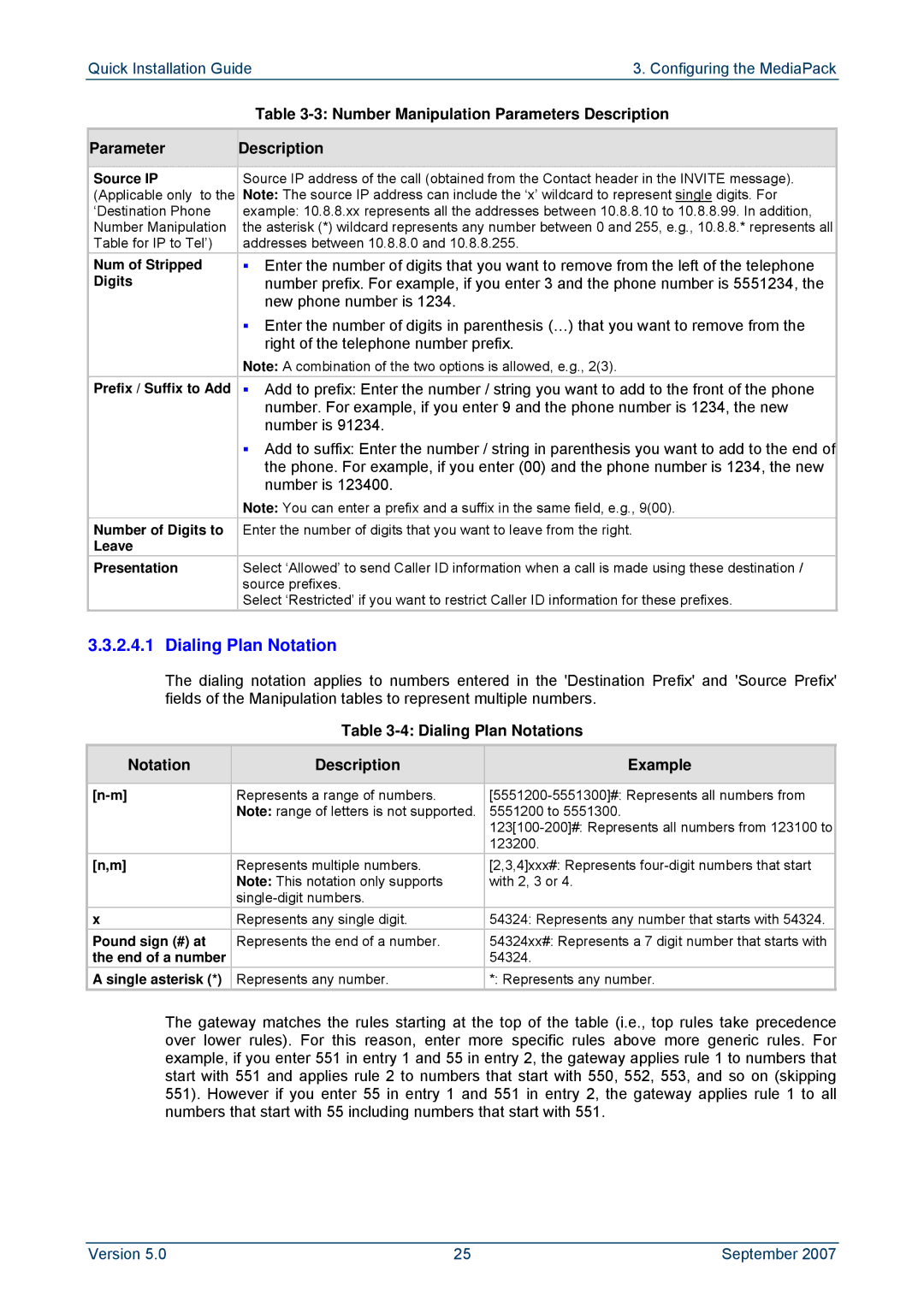Quick Installation Guide | 3. Configuring the MediaPack | |
| Table | |
|
|
|
Parameter | Description |
|
|
| |
Source IP | Source IP address of the call (obtained from the Contact header in the INVITE message). | |
(Applicable only to the | Note: The source IP address can include the ‘x’ wildcard to represent single digits. For | |
‘Destination Phone | example: 10.8.8.xx represents all the addresses between 10.8.8.10 to 10.8.8.99. In addition, | |
Number Manipulation | the asterisk (*) wildcard represents any number between 0 and 255, e.g., 10.8.8.* represents all | |
Table for IP to Tel’) | addresses between 10.8.8.0 and 10.8.8.255. |
|
Num of Stripped | Enter the number of digits that you want to remove from the left of the telephone | |
Digits | number prefix. For example, if you enter 3 and the phone number is 5551234, the | |
| new phone number is 1234. |
|
| Enter the number of digits in parenthesis (…) that you want to remove from the | |
| right of the telephone number prefix. |
|
| Note: A combination of the two options is allowed, e.g., 2(3). |
|
Prefix / Suffix to Add | Add to prefix: Enter the number / string you want to add to the front of the phone | |
| number. For example, if you enter 9 and the phone number is 1234, the new | |
| number is 91234. |
|
| Add to suffix: Enter the number / string in parenthesis you want to add to the end of | |
| the phone. For example, if you enter (00) and the phone number is 1234, the new | |
| number is 123400. |
|
| Note: You can enter a prefix and a suffix in the same field, e.g., 9(00). | |
Number of Digits to | Enter the number of digits that you want to leave from the right. |
|
Leave |
|
|
Presentation | Select ‘Allowed’ to send Caller ID information when a call is made using these destination / | |
| source prefixes. |
|
| Select ‘Restricted’ if you want to restrict Caller ID information for these prefixes. | |
3.3.2.4.1 Dialing Plan Notation
The dialing notation applies to numbers entered in the 'Destination Prefix' and 'Source Prefix' fields of the Manipulation tables to represent multiple numbers.
Table 3-4: Dialing Plan Notations
Notation | Description | Example |
|
|
|
Represents a range of numbers. | ||
| Note: range of letters is not supported. | 5551200 to 5551300. |
|
| |
|
| 123200. |
[n,m] | Represents multiple numbers. | [2,3,4]xxx#: Represents |
| Note: This notation only supports | with 2, 3 or 4. |
|
| |
x | Represents any single digit. | 54324: Represents any number that starts with 54324. |
Pound sign (#) at | Represents the end of a number. | 54324xx#: Represents a 7 digit number that starts with |
the end of a number |
| 54324. |
A single asterisk (*) | Represents any number. | *: Represents any number. |
The gateway matches the rules starting at the top of the table (i.e., top rules take precedence over lower rules). For this reason, enter more specific rules above more generic rules. For example, if you enter 551 in entry 1 and 55 in entry 2, the gateway applies rule 1 to numbers that start with 551 and applies rule 2 to numbers that start with 550, 552, 553, and so on (skipping 551). However if you enter 55 in entry 1 and 551 in entry 2, the gateway applies rule 1 to all numbers that start with 55 including numbers that start with 551.
Version 5.0 | 25 | September 2007 |
